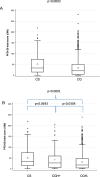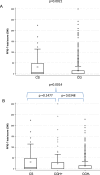Impact of gynecologic cancer on pelvic floor disorder symptoms and quality of life: an observational study
- PMID: 30783163
- PMCID: PMC6381087
- DOI: 10.1038/s41598-019-38759-5
Impact of gynecologic cancer on pelvic floor disorder symptoms and quality of life: an observational study
Abstract
The objective of our observational prospective study was to investigate the severity and prevalence of urinary and pelvic floor disorders in gynecologic cancer survivors. All patients surviving gynecological cancer in the region as well as women receiving invitations to attend breast-screening checkups as the control population were asked to fill-in questionnaires assessing pelvic prolapse symptoms (PFDI-20, Wexner) and associated quality of life (PFIQ-7). Eighty-nine women were included in the cancer survivor group and 1088 in the control group. Pelvic floor symptoms (PFDI-20 questionnaire) were significantly worse in cancer survivors than in control women (score: 33.3 [14.6-74.1] vs. 20 [4.2-50.0], p = 0.0003). Urge incontinence was significantly worse in cancer survivors in both univariable (ORb = 2.061 [95% CI = 1.284-3.309], p = 0.0027) and multivariable analyses (ORa = 1.672 [95% CI = 1.014-2.758], p = 0.0442), as was fecal incontinence in univariable (ORb = 3.836 [95% CI = 1.710-8.602], p = 0.0011) and in multivariable (ORa = 3.862 [95% CI = 1.657-9.001], p = 0.0018) analyses. Women with benign hysterectomies had poorer quality of life and increased pelvic floor disorders compared to women with no history of surgery. Survivors of gynecological cancer experience significantly more pelvic floor symptoms and an associated reduction in quality of life.
Conflict of interest statement
The authors declare no competing interests.
Figures



References
-
- Ferlay J, et al. Cancer incidence and mortality patterns inEurope: estimates for 40 countries in 2012. Eur. J. Cancer Oxf. Engl. 1990. 2013;49:1374–1403. - PubMed
-
- Council, I. of M. and N. R. From Cancer Patient to Cancer Survivor: Lost in Transition, 10.17226/11468 (2005).
-
- Cancer Survivorship - United States, 1971–2001. Available at, https://www.cdc.gov/mmwr/preview/mmwrhtml/mm5324a3.htm (Accessed: 19th November 2017).
-
- us_cancer_statistics_2004_incidence_and_mortality.pdf. Available at, https://www.cdc.gov/cancer/npcr/npcrpdfs/us_cancer_statistics_2004_incid... (Accessed: 19th November 2017).
Publication types
MeSH terms
LinkOut - more resources
Full Text Sources
Medical

